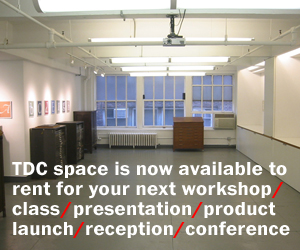Hidden Meanings and Hot Wheels Logos: Talking Type with TDC 63 Judge Xerxes Irani
As the entries pour in for TDC 63 and Typography 38 we are excited to introduce some of the vastly talented people who make up our international team of judges.
Xerxes Irani is a third-generation creative professional. During his career he has been an ad agency Creative Director, a professor at the Alberta College of Art & Design (ACAD), and the founding partner of two successful design studios—both of which are still alive and well today. He was previously the Creative Director for Corbis (and Veer), where he led a network of creative teams in Calgary, Seattle, China and London.
He is currently Principal Designer on the Amazon homepage where he works with teams across the entire organization setting the content creative direction.
Among his personal projects to date, Xerxes has had seven stamps printed and one coin minted by Canada Post. He also specializes in brand positioning projects with the estates of Muhammad Ali, Martin Luther King, Jr., Albert Einstein, and Alfred Hitchcock to name a few.
Your experience includes being a professor at Alberta College of Art & Design. How do you explain the importance of typography to aspiring young designers?
When someone starts speaking there are a few things we clue into: the sound of their voice, the words they are saying, our comprehension of the content and the tone in which they are communicating to reveal the emotion of it all.
Typography is all of these things represented visually. The characters and style of the letterforms help us understand how to feel. The typeface is an indicator of mood, whether that be stern and serious, playful or elegant. At ACAD, we would do an exercise early in the year where we would speak the words prior to setting them – a vocal run. This would set the visual tone for the work – but also help the student feel the intent of the copy.
In the end, good typography considers all of these things and a conversation that is lacking any one of these elements always feels off.
How did you first become interested in design, and what role did type play in your early awareness?
My obsession with type and letters started early. My father was an architect and his penmanship was the first typeface I was drawn to. His R’s were always the same, it blew my mind, this was the beginning of my fascination with letterforms. I also love playing with words, combining them—giving people and things nicknames—some would call it a passion, others call it aggravating.
My interest in letterforms spilled over into packaging and album covers. Even from a young age I could not stop looking at band logos, almost obsessed with their intrinsic meaning. What was the KISS logo saying to me that the Rolling Stones logo wasn’t? What were the decisions made in drawing the Hot Wheels logo that were different from the Batman logo? I began to realize that there was a hidden meaning behind all of this; one we were all taking in but might not be aware of.
Once I realized this the world became a puzzle. Every single thing had a meaning that was behind the words. At the same time, my first and only drum teacher told me good drumming was about the space between the beats—not the beats themselves, I drew a parallel between music and typography. The rest was history… Good music and good typography consider the things that we aren’t aware of and bring us along to feel them.
How has your work creating postage stamps and coins affected your design thinking? Has working in such a small format influenced how you think about other limited-scale mediums, like mobile devices?
Postage stamps are challenging for me. How do you represent 100 years of anything in a square inch of space without leaving things out? The distillation of this information is key. I find that this is the same kind of thinking that goes into my daily work on smaller handheld devices. The staging of information is critical. The smaller the space, the more we must be sure that the information is in the right place at the right time. Stamps use iconography to tell a story quickly in a small space; mobile device experiences do the same thing for sure. The similarities begin and end with being able to distill the most important information down for that exact moment—that is the eternal struggle of all creatives.




